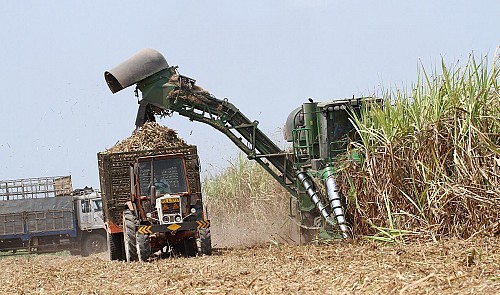Vietnam sugarcane industry faces challenge from climate change, foreign rivals

A tractor harvests sugarcane in Vietnam. Tuoi Tre
The 2015-2016 season marks the decline of sugar output for the second year in a row, after many years of growth.
According to information from the Ministry of Agriculture and Rural Development, the sugarcane industry occupied an area of 284,000 ha in the 2015-16 season, a 6.7 percent decrease compared to last season, and produced 18.3 million metric tons, an eight percent decrease.
A total of 13 million metric tons of sugarcane was manufactured into 1.5 million metric tons of sugar, 60,000 tons lower than the target for the season and 10.4 percent lower than the output from last season.
Sugar output has decreased for the second year in a row, prompting the Ministry of Industry and Trade to ask the government to ratify the import of 200,000 metric tons of sugar in order to add to the national supply.
The quality of sugarcane is also in decline, with sugar recovery ratio dropping to 9.64 CCS, 0.56 CCS lower than that of last season.
The decrease in quantity and quality of sugarcane in Vietnam is due to the effects of climate change, as drought and salt intrusion affect the production of sugarcane in the Central Highlands and southern regions.
Many experts have also forecasted that drought and salt intrusion will exacerbate during the 2016-17 season, affecting a larger area, especially in the Mekong Delta region.
Foreign rivals
Furthermore, Vietnamese sugarcane is facing challenges from foreign competitors as upcoming free trade agreements will allow foreign sugar to enter the domestic market without much difficulty.
According to the Department of Crop Production, sugarcane productivity in Vietnam is only 90 percent compared to the global average, not to mention that of sugarcane powerhouses such as Brazil, Australia, Thailand, and India.
Nguyen Hai, General Secretary of Vietnam Sugar Association, warned that domestic sugarcane will face dire consequences from free trade agreements signed with other countries.
Tariffs for sugar has been reduced to 5 percent since 2010, while a new border trade agreement between Vietnam and Laos will allow sugar products produced by Hoang Anh Gia Lai group in Laos to be imported into Vietnam with no tariff and value-added tax.
Pham Hong Duong, Chairman of the Sugar Committee of TTC Group, claimed that Vietnam’s sugarcane industry needs to invest in mechanization and cutting-edge technology.
According to Duong, watering is an important factor in sugarcane farming, but except the Mekong Delta region, no other areas have the natural resources for additional watering, leaving sugarcane plants to rely only on rainwater for growth.
Statistics from the Ministry of Agriculture and Rural Development revealed that the area of sugarcane with additional watering is only 17,000ha.
In normal conditions, additional watering will increase productivity by 35 to 50 percent compared to sugarcane farming that only relies on rainwater.
Therefore, the application of watering technology will be a crucial method to increasing sugarcane productivity in the future, Duong asserted.
The mechanization of plowing will decrease cost by 25 to 33 percent and double plowing depth from 25 to 30 centimeters to 50 to 60 centimeters, allowing sugarcane plants to grow faster and healthier.
Furthermore, mechanizing sugarcane harvest will cut cost by half and increase the amount of sugarcane harvested.
“Vietnam has the extra resources to invest in mechanizing the sugarcane industry. If that is well-executed, then the sugarcane industry will be able to compete with imported sugar and even to export,” Duong said.
Source: Tuoitre News






